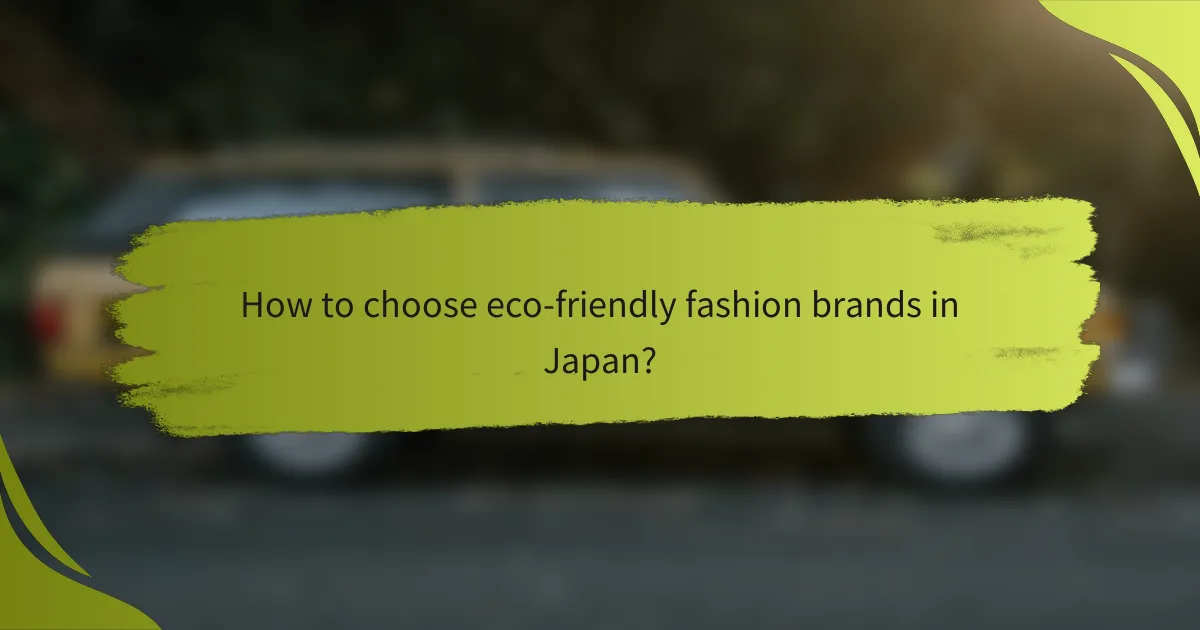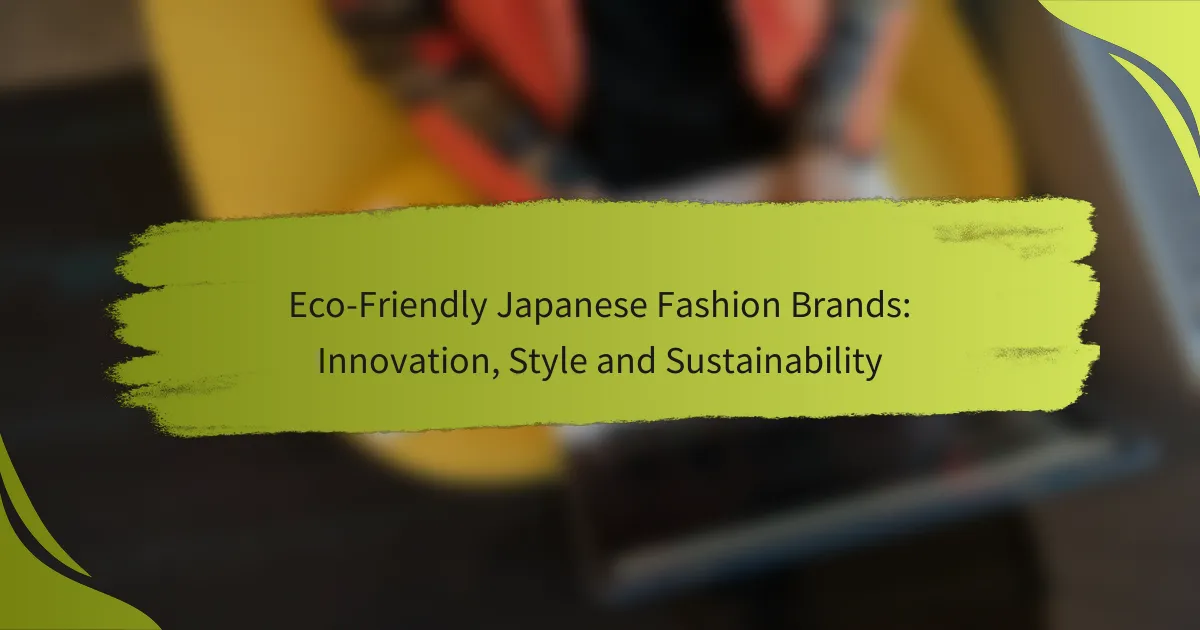日本のエコフレンドリーファッションブランドは、革新性、スタイル、持続可能性を融合させた先駆者として注目されています。これらのブランドは、環境に配慮した素材や倫理的な生産方法を優先し、持続可能性を重視する消費者にアピールしています。

Which eco-friendly Japanese fashion brands lead the market?
Several Japanese fashion brands are at the forefront of eco-friendly practices, combining innovation, style, and sustainability. These brands prioritize environmentally conscious materials and ethical production methods, appealing to consumers who value sustainability in fashion.
Muji
Muji is renowned for its minimalist design and commitment to sustainability. The brand uses organic cotton and recycled materials in its clothing lines, reducing environmental impact while maintaining a simple aesthetic.
Additionally, Muji promotes a “no-brand” philosophy, encouraging consumers to focus on quality and functionality rather than logos. This approach not only minimizes waste but also supports a more sustainable lifestyle.
Issey Miyake
Issey Miyake is celebrated for its innovative use of technology and sustainable materials. The brand has developed unique fabrics that minimize waste during production, such as its signature Pleats Please line, which is made from recycled polyester.
Furthermore, Issey Miyake emphasizes longevity in its designs, encouraging consumers to invest in timeless pieces that withstand trends and reduce the need for frequent replacements.
Uniqlo
Uniqlo has made significant strides in sustainable fashion through its “Uniqlo U” and “Re.Uniqlo” initiatives. The brand focuses on using sustainable materials, including recycled down and organic cotton, in its collections.
Uniqlo also promotes clothing recycling programs, allowing customers to return used garments for repurposing. This initiative not only reduces waste but also fosters a circular economy in fashion.
Comme des Garçons
Comme des Garçons is known for its avant-garde designs and commitment to sustainability. The brand often utilizes upcycled materials and innovative techniques to create unique pieces that challenge conventional fashion norms.
By focusing on creativity and sustainability, Comme des Garçons encourages consumers to appreciate fashion as an art form while being mindful of environmental impacts.
H&M Conscious Collection
The H&M Conscious Collection represents the brand’s commitment to sustainability by offering stylish clothing made from organic and recycled materials. This line aims to provide fashionable options that are also environmentally friendly.
H&M also invests in sustainable production practices and transparency in its supply chain, allowing consumers to make informed choices about their purchases. The Conscious Collection is a step towards reducing the overall carbon footprint of fast fashion.

How do these brands incorporate sustainability?
Eco-friendly Japanese fashion brands incorporate sustainability through innovative practices that minimize environmental impact. They focus on using organic materials, implementing recycling programs, and ensuring ethical labor practices to create stylish yet responsible clothing.
Use of organic materials
Many Japanese fashion brands prioritize the use of organic materials, such as cotton, linen, and hemp, which are grown without harmful pesticides or synthetic fertilizers. This approach not only reduces chemical runoff but also promotes healthier farming practices.
Brands often seek certifications like GOTS (Global Organic Textile Standard) to ensure their materials meet strict environmental and social criteria. By choosing organic fabrics, consumers can support sustainable agriculture and reduce their carbon footprint.
Recycling programs
Recycling programs are a key component of sustainability in Japanese fashion. Many brands encourage customers to return old garments for recycling or upcycling, thus extending the life cycle of clothing and reducing waste.
Some companies offer incentives, such as discounts on future purchases, to motivate customers to participate. This not only fosters a circular economy but also raises awareness about the importance of reducing textile waste.
Ethical labor practices
Ethical labor practices are essential for sustainable fashion, and many Japanese brands are committed to fair wages and safe working conditions. They often collaborate with local artisans and factories that adhere to labor laws and ethical standards.
By supporting brands that prioritize ethical labor, consumers can contribute to a more equitable fashion industry. Transparency in supply chains is increasingly emphasized, allowing customers to make informed choices about their purchases.

What innovative practices are adopted in eco-friendly fashion?
Eco-friendly fashion incorporates various innovative practices aimed at reducing environmental impact while maintaining style. These practices focus on sustainability, resource efficiency, and minimizing waste throughout the production process.
Zero-waste design
Zero-waste design is a practice that aims to eliminate textile waste during the production of garments. Designers create patterns that utilize the entire fabric, leaving no leftover scraps. This approach not only conserves resources but also encourages creativity in garment construction.
Brands adopting zero-waste design often use techniques such as draping and pattern manipulation to maximize fabric usage. For example, some designers create garments that can be worn in multiple ways, further reducing the need for additional clothing.
Biodegradable fabrics
Biodegradable fabrics are made from natural fibers that can decompose over time, reducing landfill waste. Common materials include organic cotton, hemp, and Tencel, which break down more easily than synthetic fibers. This practice aligns with the goal of creating a circular fashion economy.
When choosing biodegradable fabrics, consider certifications like Global Organic Textile Standard (GOTS) to ensure sustainability. Brands are increasingly transparent about their material sourcing, making it easier for consumers to make eco-friendly choices.
3D knitting technology
3D knitting technology allows for the creation of garments with minimal waste by producing items directly from digital designs. This method uses computer-controlled machines to knit fabric in a continuous process, resulting in seamless pieces that fit better and require less finishing work.
This technology not only reduces material waste but also enables customization, as consumers can often select sizes and styles tailored to their preferences. As the technology evolves, it may become more accessible, further promoting sustainable practices in the fashion industry.

What are the benefits of choosing eco-friendly fashion?
Choosing eco-friendly fashion offers numerous advantages, including a reduced environmental footprint, support for local artisans, and healthier clothing options. These benefits not only contribute to sustainability but also enhance the overall quality of your wardrobe.
Reduced environmental impact
Eco-friendly fashion significantly lowers the environmental impact of clothing production. Brands often use sustainable materials, such as organic cotton or recycled fabrics, which require less water and energy compared to conventional textiles.
Additionally, many eco-conscious brands implement ethical manufacturing practices, reducing waste and pollution. For instance, some companies adopt a zero-waste philosophy, ensuring that every part of the material is utilized, thereby minimizing landfill contributions.
Support for local artisans
Purchasing from eco-friendly fashion brands often means supporting local artisans and small businesses. These brands typically prioritize craftsmanship and traditional techniques, which not only preserves cultural heritage but also fosters community development.
By choosing locally made products, consumers can help stimulate the local economy and create jobs. This support is crucial, especially in regions where artisan skills are at risk of disappearing due to mass production trends.
Healthier clothing options
Eco-friendly fashion often translates to healthier clothing options for consumers. Many sustainable brands avoid harmful chemicals and dyes, resulting in garments that are less likely to cause skin irritations or allergies.
Moreover, natural fibers like organic cotton and linen are breathable and comfortable, making them ideal for everyday wear. This focus on health and comfort enhances the overall wearing experience, promoting well-being alongside sustainability.

How to choose eco-friendly fashion brands in Japan?
To choose eco-friendly fashion brands in Japan, look for companies that prioritize sustainable practices, ethical sourcing, and environmentally friendly materials. Consider their certifications and transparency regarding production processes to ensure they align with eco-conscious values.
Look for certifications
Certifications can help identify brands committed to sustainability in Japan. Look for labels like GOTS (Global Organic Textile Standard) for organic textiles, or the Eco Mark, which indicates products meeting environmental standards. These certifications often require brands to adhere to strict guidelines regarding materials and production processes.
In addition to organic certifications, consider brands with Fair Trade or similar ethical certifications. These labels ensure that workers are paid fairly and work in safe conditions, which is an essential aspect of sustainable fashion. Checking for these certifications can save you time and help you make informed choices.
When evaluating a brand, research their certification claims. Some brands may use vague terms like “eco-friendly” without any backing. Look for transparency in their supply chain and production methods to ensure they genuinely practice sustainability.
